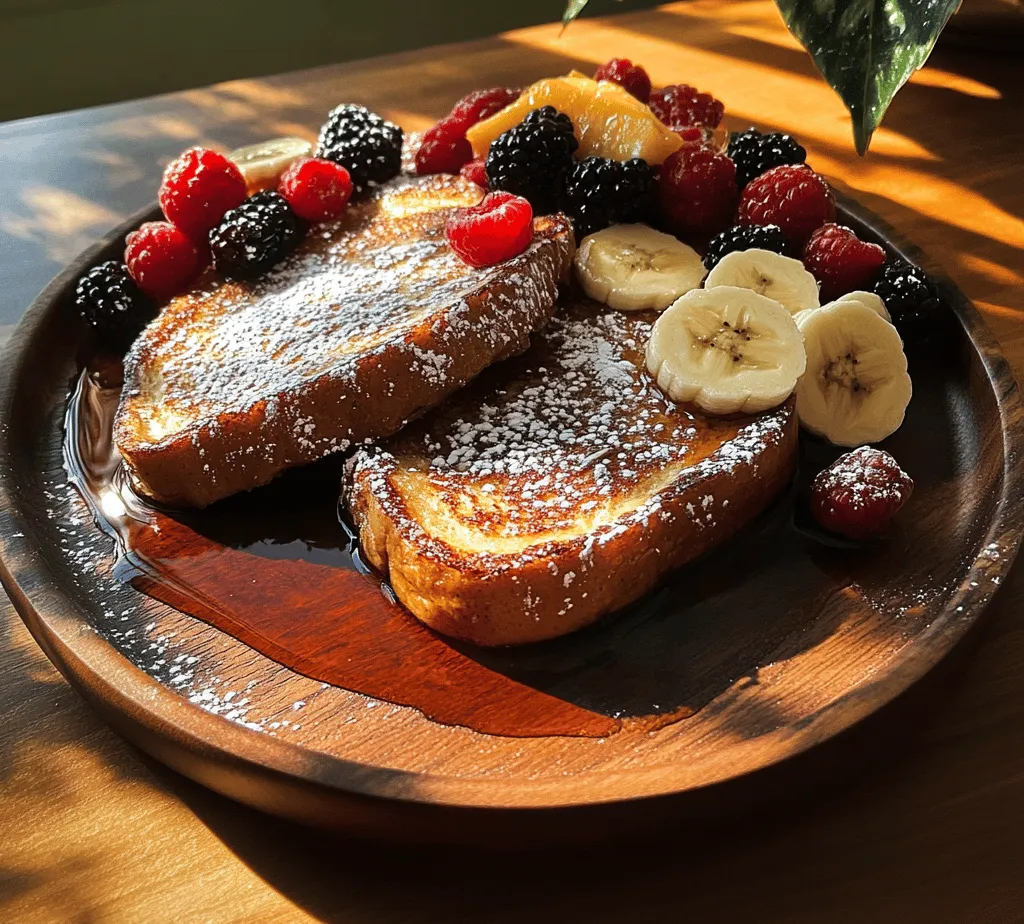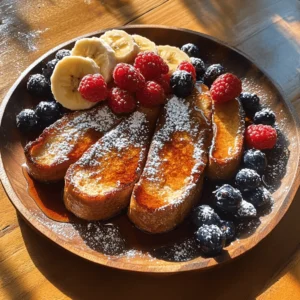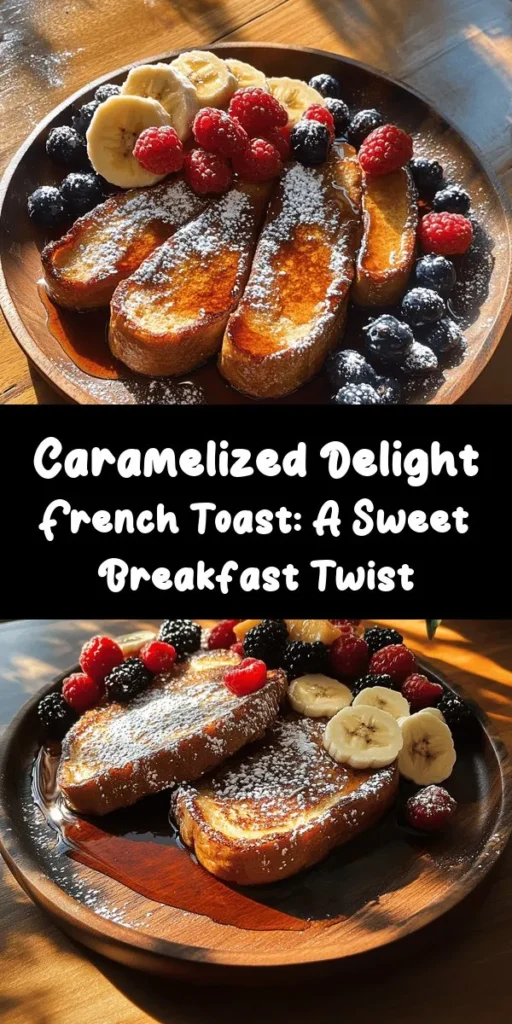Introduction
French toast is a beloved breakfast classic that has graced tables around the world for generations. Its simple yet satisfying combination of bread, eggs, and milk has made it a go-to comfort food, perfect for lazy weekend mornings or special occasions. But while traditional French toast is delightful on its own, the “Caramelized Delight French Toast” takes this classic dish to new heights with a unique twist. This recipe infuses the comforting flavors of caramelization, adding a rich, sweet depth that enhances the overall experience of this breakfast favorite.
The appeal of caramelization lies in its ability to transform ordinary ingredients into something extraordinary. When sugar is heated, it undergoes a magical transformation, creating a golden-brown crust that is both visually appealing and deliciously flavorful. This caramelized layer not only elevates the taste but also adds a delightful texture that contrasts beautifully with the soft and pillowy interior of the toast. In this article, we will dive into the world of Caramelized Delight French Toast, exploring its rich history, cultural significance, and the key ingredients that make this dish truly special.
The Allure of French Toast
French toast, known as “pain perdu” in France, which translates to “lost bread,” has a history that dates back centuries. It is believed that ancient Romans were the first to enjoy a version of this dish, soaking stale bread in a mixture of milk and eggs before frying it. Over time, this culinary tradition spread across cultures, each adding its unique flair. In America, French toast gained popularity in the early 19th century, often featuring thick slices of bread and a variety of toppings, such as syrup, fruits, and powdered sugar.
The cultural significance of French toast can be seen in its adaptability to regional preferences and seasonal ingredients. From the indulgent brioche used in French cafés to the rustic sourdough found in American diners, the versatility of French toast is one of its most appealing traits. Whether served as a simple breakfast or dressed up for brunch with gourmet toppings, French toast can be customized to suit any palate or occasion.
The Versatility of French Toast
One of the most exciting aspects of French toast is its versatility. The base recipe can be easily modified to incorporate different types of bread, flavors, and toppings. For instance, you can use brioche or challah for a rich and buttery texture, or opt for whole grain bread for a healthier option. The egg mixture can be enhanced with spices such as nutmeg or cardamom, or even infused with orange zest for a refreshing twist.
Toppings are where the real creativity shines. Classic maple syrup is a favorite, but you can also experiment with fresh fruits like berries, bananas, or peaches. For those with a sweet tooth, whipped cream, chocolate sauce, or caramel drizzle can take your French toast to decadent new heights. The Caramelized Delight French Toast is a perfect example of this versatility, showcasing how a few key ingredients and techniques can elevate a timeless dish into a gourmet experience.
Key Ingredients for Caramelized Delight French Toast
To create the perfect Caramelized Delight French Toast, you’ll need a selection of key ingredients that come together to form a deliciously rich and satisfying meal. Here’s a breakdown of what you will need:
1. Thick Bread Varieties
The foundation of any great French toast is the bread. For this recipe, thick slices of bread are essential to ensure that they hold up during the soaking process. Brioche and challah are excellent choices due to their rich texture and slightly sweet flavor. These breads absorb the custard mixture beautifully, resulting in a soft, custardy interior while achieving a perfect golden-brown exterior when cooked.
2. Eggs
Eggs are the cornerstone of the custard mixture that gives French toast its creamy texture. They provide structure and richness, ensuring that each slice of bread is evenly coated and infused with flavor. For this recipe, large eggs work best, as they create a smooth and thick custard that clings to the bread.
3. Milk
Milk is crucial for achieving a creamy and flavorful custard. It adds moisture and richness to the egg mixture, enhancing the overall taste of the French toast. Whole milk is recommended for its creaminess, but you can also use alternatives like almond milk or oat milk if you prefer a dairy-free option.
4. Vanilla Extract
A splash of vanilla extract elevates the flavor of the custard mixture. Its warm and inviting aroma complements the sweetness of the caramelization, creating a delightful sensory experience. Make sure to use pure vanilla extract for the best flavor; imitation vanilla can lack the depth of taste you want in this recipe.
5. Brown Sugar and Ground Cinnamon
Brown sugar adds a delicious sweetness to the custard while also contributing to the caramelization process when cooked. Ground cinnamon, with its warm and comforting spices, enhances the overall flavor profile of the dish. Together, these ingredients create a cozy atmosphere that is perfect for breakfast or brunch.
6. Butter
Butter is essential for cooking the French toast to perfection. It not only adds flavor but also allows for even browning and caramelization. Using unsalted butter gives you control over the saltiness of the dish, allowing the sweetness of the caramelized bread to shine through.
7. Maple Syrup and Optional Toppings
While the Caramelized Delight French Toast is delicious on its own, serving it with maple syrup takes it to another level. The rich, sweet syrup pairs perfectly with the caramelized notes of the toast. Additionally, you can enhance your dish with optional toppings such as fresh fruits, whipped cream, or a dusting of powdered sugar for a beautiful presentation.
Preparation Steps: A Step-by-Step Guide
Now that we have gathered all the essential ingredients for our Caramelized Delight French Toast, it’s time to dive into the preparation process. Follow these detailed steps to create a breakfast masterpiece.
Step 1: Prepare the Egg Mixture
The first step in making Caramelized Delight French Toast is preparing the custard mixture. In a mixing bowl, crack the eggs and whisk them thoroughly until the yolks and whites are well combined. This step is crucial for achieving a smooth batter that will coat the bread evenly. Next, add in the milk, vanilla extract, brown sugar, and ground cinnamon. Continue whisking until all ingredients are fully incorporated, and the mixture is smooth and creamy.
Step 2: Soak the Bread
Once your egg mixture is ready, it’s time to soak the bread. Using thick slices of brioche or challah, carefully dip each slice into the egg mixture, ensuring that both sides are well coated. Allow the bread to soak for a few seconds, but be cautious not to over-soak, as this can cause the bread to disintegrate. The goal is to achieve optimal absorption, so that the bread becomes moist but still retains its structure. A brief soak of about 15-30 seconds per side is typically sufficient.
Step 3: Heat the Pan
Before cooking the French toast, it’s important to heat your pan to the right temperature. Place a large skillet or griddle over medium heat and add a tablespoon of butter. Allow the butter to melt and bubble, creating a rich, flavorful base for your French toast. Proper heat control is crucial; if the pan is too hot, the outside may burn while the inside remains uncooked. Conversely, if the heat is too low, the toast will not caramelize properly.
Step 4: Cook the French Toast
Once the pan is heated, it’s time to cook the French toast. Place the soaked bread slices in the skillet, making sure not to overcrowd the pan. Cook each slice for about 3-4 minutes on one side, or until golden brown and caramelized. Carefully flip the slices and cook for an additional 2-3 minutes on the other side. As you cook, you may need to adjust the heat to ensure even browning. Repeat this process until all the slices are cooked, adding more butter to the pan as needed.
Step 5: Serve and Enjoy
As soon as your Caramelized Delight French Toast is cooked to perfection, it’s time to serve! Arrange the slices on a plate and drizzle with warm maple syrup. Add your choice of toppings, such as fresh fruits or a dusting of powdered sugar, to create a visually appealing and delicious breakfast.
By following these steps, you’ll have a stunning plate of Caramelized Delight French Toast that is sure to impress family and friends alike. The combination of caramelization and soft, custardy bread creates a breakfast experience that is both comforting and indulgent. In the next part of this article, we will explore additional tips for achieving the best results with this recipe, as well as answer some common questions about making French toast. Stay tuned!

Caramelization Process: The Science Behind Caramelizing and Achieving a Golden Crust
Caramelization is a culinary technique that transforms sugar into a rich, golden-brown substance that adds depth and flavor to many dishes, including our Caramelized Delight French Toast. Understanding the science behind caramelization can help you achieve that perfect golden crust that not only looks beautiful but also enhances the overall taste of your dish.
When sugar is exposed to heat, it undergoes a series of chemical reactions known as caramelization. This process begins at approximately 320°F (160°C), where the sugar molecules break down and form new compounds, resulting in that characteristic caramel flavor. The key to successful caramelization in French toast lies in the right temperature and timing. Too low, and the sugar won’t caramelize; too high, and it can burn, creating a bitter taste.
To achieve that perfect golden crust on your French toast, use a mixture of butter and a touch of sugar in your pan. The butter adds flavor and prevents sticking, while the sugar caramelizes to create that desirable crust. Be patient and allow the heat to build gradually; this way, you’ll ensure even caramelization without burning. Flip the toast carefully to maintain that beautiful crust on both sides. The result is a sweet, crunchy exterior that perfectly complements the soft, custardy interior of the French toast.
Serving Suggestions and Pairings
Now that you have mastered the art of caramelization, it’s time to consider how to serve your Caramelized Delight French Toast. Here are some delightful ideas to elevate your breakfast experience:
– Drizzling with Maple Syrup: One of the classic accompaniments for French toast is maple syrup. However, not all maple syrups are created equal. From light to dark varieties, each type offers different flavor profiles. Light syrup is milder and perfect for those who prefer a subtle sweetness, while darker syrups have a robust flavor that pairs beautifully with the caramelized notes of the toast. For a gourmet twist, consider trying flavored syrups like vanilla or pecan, which can add an extra layer of richness.
– Adding Fresh Fruits: Incorporating seasonal fruits not only enhances the visual appeal of your dish but also adds nutritional benefits. Berries, bananas, and sliced peaches work exceptionally well. Berries provide a burst of freshness and antioxidants, while bananas add creaminess and natural sweetness. Seasonal fruits can be lightly sautéed in a pan with a sprinkle of sugar, creating a warm topping that complements the caramelized toast perfectly.
– Garnishing with Powdered Sugar: A light dusting of powdered sugar can elevate the aesthetic of your French toast while adding a hint of sweetness. Use a fine mesh sieve to create a snow-like effect over your dish. This not only enhances presentation but also offers a delightful contrast to the rich flavors of the caramelized crust. For an extra touch, consider adding a sprinkle of cinnamon or nutmeg along with the powdered sugar for added flavor.
Nutritional Insights
Understanding the nutritional benefits of the main ingredients in your Caramelized Delight French Toast can help you appreciate this delicious breakfast dish even more.
– The Role of Eggs and Milk: Eggs and milk are fundamental ingredients in French toast, providing essential nutrients. Eggs are an excellent source of protein, healthy fats, and vitamins such as B12 and D. They contribute to the custardy texture of French toast and help bind the other ingredients together. Milk, whether whole or a dairy alternative, adds creaminess and calcium, vital for bone health. Opting for nutrient-rich milk or fortified dairy alternatives can further enhance the nutritional profile.
– Whole Ingredients vs. Processed Alternatives: Using whole ingredients instead of processed alternatives can significantly impact the nutritional value of your French toast. For instance, opting for whole-grain bread instead of white bread increases fiber content, supporting digestive health. If you’re looking to reduce processed sugars, consider using natural sweeteners like honey or pure maple syrup. These alternatives not only provide sweetness but also come with added health benefits, such as antioxidants.
Variations to Explore
Once you’ve mastered the basic recipe, there are endless possibilities for variations to keep your breakfast exciting. Here are some creative twists to consider:
– Incorporating Spices: Elevate the flavor of your French toast by adding spices like nutmeg or cardamom to the egg mixture. Nutmeg imparts a warm, comforting aroma, while cardamom adds a hint of exotic flavor. A dash of cinnamon can also enhance the sweetness and warmth of the dish. Experimenting with spices can create a unique taste profile that keeps each breakfast fresh and enticing.
– Using Different Types of Bread: The type of bread you use can significantly impact the texture and flavor of your French toast. Brioche, challah, or even sourdough can provide varied textures, from soft and fluffy to crisp and chewy. For a healthier option, whole-grain or gluten-free bread can be just as satisfying and delicious. Each type of bread absorbs the egg mixture differently, so don’t hesitate to try several varieties.
– Alternative Sweeteners: If you’re looking to reduce refined sugar intake, consider using alternative sweeteners such as honey, agave nectar, or maple sugar. Each of these sweeteners brings its unique flavor profile and can be adjusted to suit your taste preferences. For a low-calorie option, consider using stevia or monk fruit sweeteners, which can provide sweetness without the calories.
The Perfect Occasion for Caramelized French Toast
Caramelized Delight French Toast is versatile enough to shine on various occasions, making it a perfect choice for many gatherings.
– Family Brunches: Whether it’s a weekend treat or a special holiday brunch, this French toast can impress your family and friends. Set up a create-your-own French toast station with toppings and sauces to allow everyone to personalize their dish. This interactive element adds a fun twist to your brunch!
– Holiday Breakfasts: Consider serving this dish during festive holidays. Its rich and indulgent nature makes it a perfect breakfast for celebrations like Christmas or Easter. Pair it with mimosas or freshly brewed coffee to elevate the experience.
– Cozy Weekend Mornings: Enjoying a leisurely breakfast on a Saturday or Sunday morning can be a delightful ritual. Treat yourself to a plate of Caramelized Delight French Toast while catching up on your favorite book or show. It’s an excellent way to start your day on a sweet note.
– Special Treats for Guests or Celebrations: Hosting friends or family? This French toast makes for an impressive centerpiece at any gathering. With its eye-catching appearance and delightful flavors, it’s sure to be a hit. Serve it with a side of whipped cream or flavored yogurt for an extra indulgent touch.
Conclusion
In wrapping up the delightful journey of making and enjoying Caramelized Delight French Toast, it’s clear that this dish is more than just a breakfast option; it’s an experience that brings joy to the table. From mastering the science of caramelization to exploring creative variations and perfect pairings, there’s no limit to the creativity you can unleash in your kitchen.
Whether you’re treating yourself to a cozy morning at home or impressing guests at a special gathering, this French toast recipe is versatile and adaptable, ready to cater to any occasion. Embrace the art of breakfast, and let your creativity flow as you explore the joys of cooking. With every bite of the caramelized goodness, you’ll discover the simple pleasure of a well-crafted meal, reminding us all of the delightful moments that come with sharing food and laughter around the table. Enjoy your culinary adventure!



